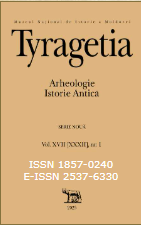Bronze- und eisenzeitliche verbindungen in eurasien. Vorläufige betrachtungen anhand einer sondergattung
Bronze and Iron Age connections in Eurasia. Preliminary observations based on a special genus
Author(s): Tudor SoroceanuSubject(s): Archaeology, Health and medicine and law, Prehistory
Published by: Muzeul Naţional de Istorie a Moldovei
Keywords: Eurasia; Bronze and Iron Ages; interconnections; metal ornaments; port;
Summary/Abstract: In this article we have set out to address, in a preliminary manner, the issues raised by a particular category of rings, namely those of small size, provided at the ends with, at least, a disc-shaped spiral. The main goal was to address – as far as possible – all the topics related to the research of these rings, in order to obtain an overview, which would serve as a starting point for an in-depth research. The three-hundred-year interest in wearing pieces with discoidal spirals (starting with Rhode, Rhode 1720) makes the scientific task even more difficult, not least because of the impressive diversity of names given to one and the same object. The first element that needed to be clarified was the establishment of an exact definition of the object of research. The main difficulty consisted in the fact that most researchers took as a basis for the typology a wearing element, considering wearing on the finger (Fingerring) as a benchmark in typological matters. However, it can be noted that, along with frequent wearing on the finger, there are also various other possibilities, such as hair rings, temple rings, pendants, etc. (fig. 5). Consequently, the name adopted by us was the following: small ring (approx. 1-3 cm), provided with at least one disc-shaped spiral. In the typology we conceived, we introduced not only the number of spirals and the section of the rod, but also the number of disc-shaped spirals (1-4), their shape, as well as typologically special specimens, some of them unique in character. The typological chart was designed in such a way that it could offer a permanent enrichment with new typological elements that are still unknown. The chronology of the type of piece we are dealing with also had to be revised, noting an extension in time of its use. Consequently, the beginnings are already placed in the early period of the Bronze Age and last, sometimes, until the 4th century BC. B.C. The main phases of evolution can be correlated: 1) with the final period of the Early Bronze Age and with the Middle Bronze Age; 2) with the Urnfield Period (BD-HaB) and 3) with the Middle and Late Hallstatt; in some areas, such as North-West Italy and the North Caucasus, the production and use of the piece can be extended until the 4th century. The spread of the discoid spiral ring also appears to have other dimensions than those adjudicated until recently: the real existence of the ring type takes place in a space that goes far beyond the Central European framework, with the two extensions to the south. The distribution map (fig. 6) shows us undoubtedly the extent and Euro-Asian significance of the piece in question: outside the “won” space between the Tisza, the North Caucasus and the South Urals, a clear extension is outlined throughout the South of Western Siberia up to the Obi, but also in North Kazakhstan. These few new elements of the research offer, we believe, not only another perspective in the interpretation of the type of piece as such, but also oblige us to deepen the research of a possible Euro-Asian koiné, despite so many elements that fragment it.
Journal: Tyragetia (Serie Nouă)
- Issue Year: XVII/2023
- Issue No: 1
- Page Range: 33-94
- Page Count: 62
- Language: German

